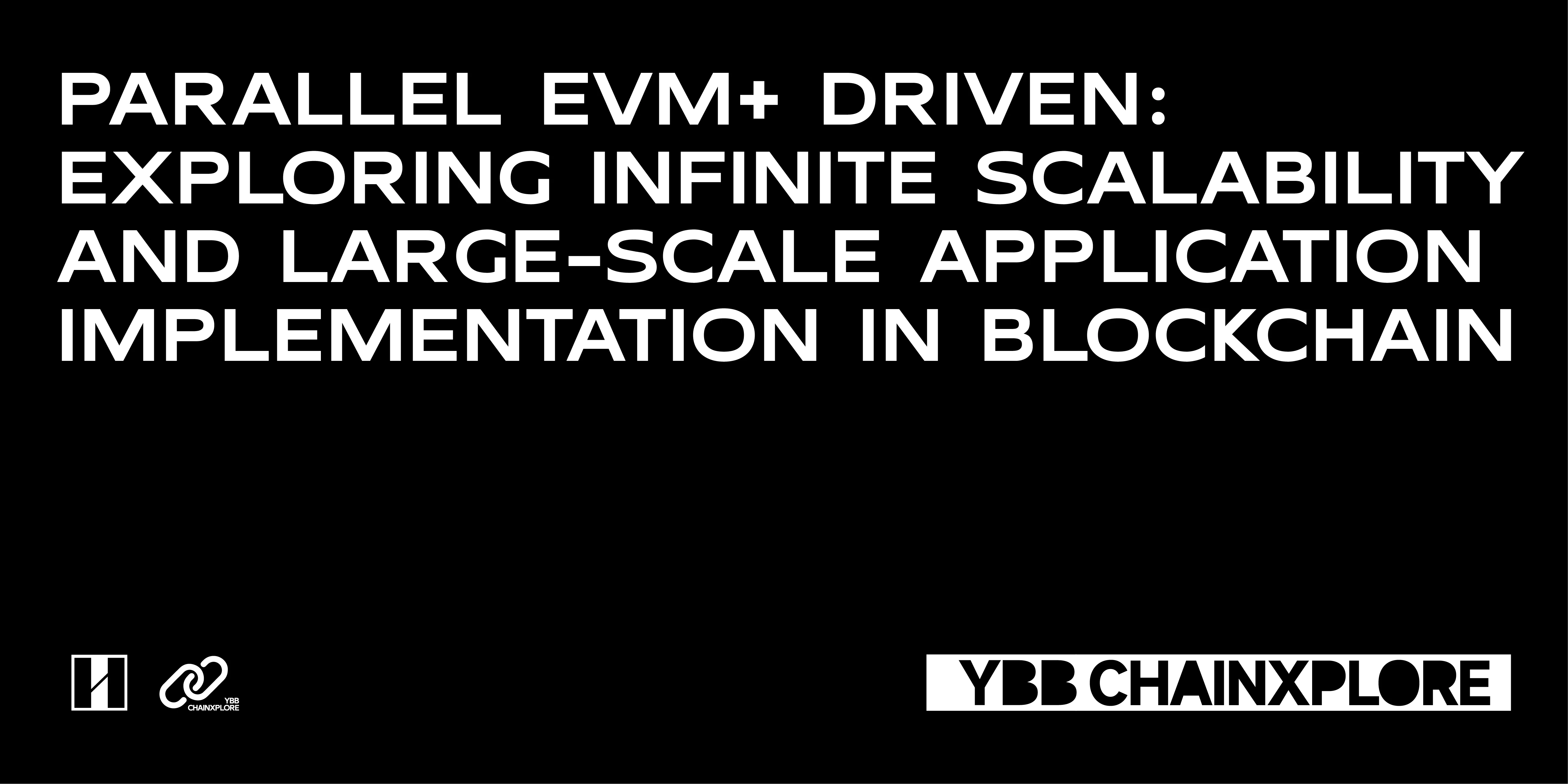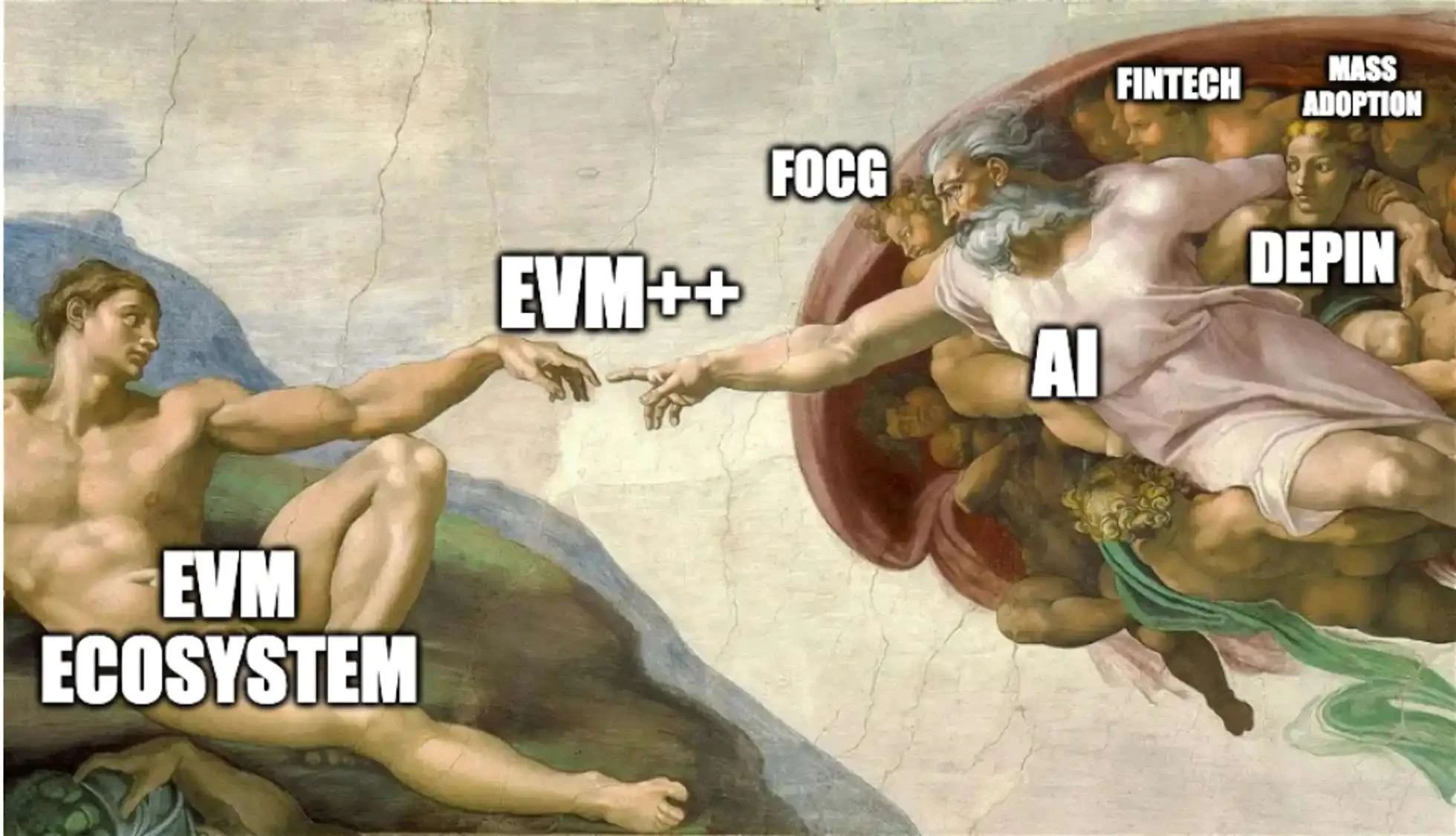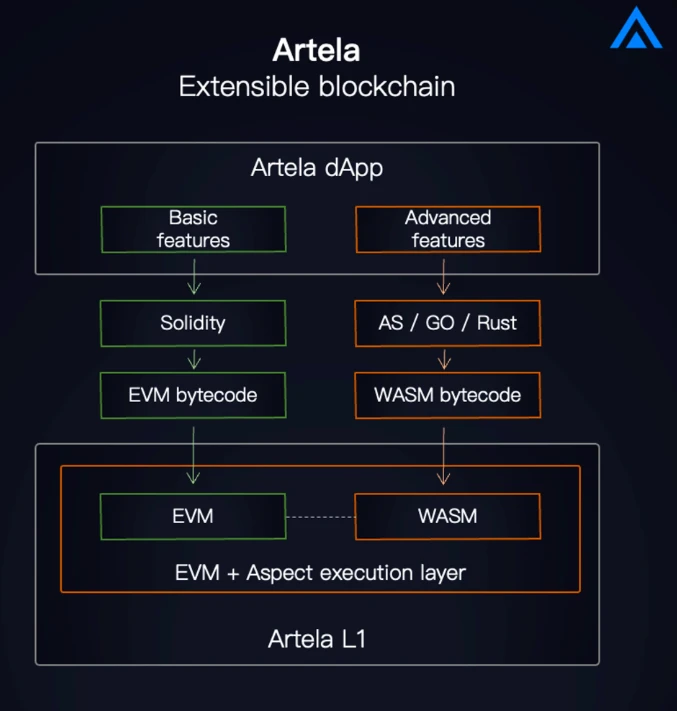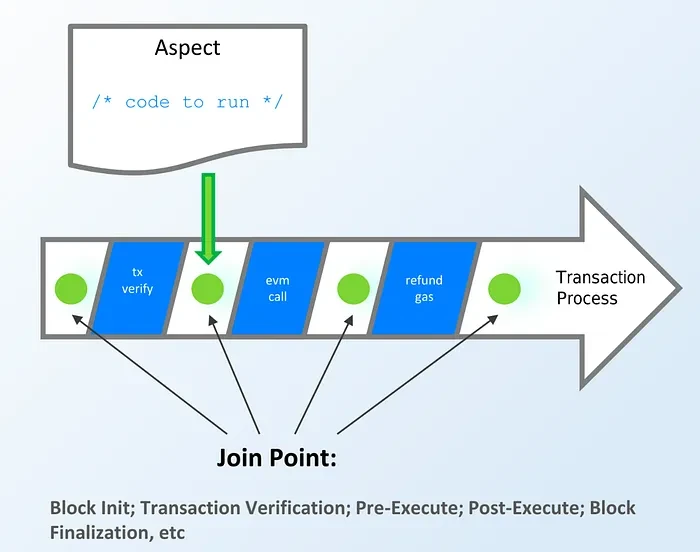Original author: YBB Capital Researcher Ac-Core

Preface:
EVM+ is an advanced model specifically designed to drive further development of the Ethereum Virtual Machine to better adapt to the rapidly changing crypto space. In this model, as the innovation and productivity of Web2 are gradually integrated into Web3, practical technologies such as artificial intelligence, DePIN and DeFi security are also being rapidly integrated into crypto applications. EVM+ provides a new solution that not only promotes the development of large-scale applications, but also accelerates the integration of cryptocurrencies with mainstream applications by seamlessly integrating EVM assets, protocols and infrastructure. It enhances the scalability of the blockchain by implementing native extensions on the EVM+WASM chain, and further optimizes the processing power of the blockchain by supporting parallel EVM execution.
According to Techandtips 123, parallel EVM is like the division of labor when organizing a party. Suppose you need to prepare for the move and let everyone do their own job: A transports large luggage, B transports valuables, C is responsible for moving items, and D is responsible for the sanitation layout of the new site. This division of labor allows the entire work to be completed by four people, greatly saving time and improving efficiency.
The concept of parallel EVM is similar, it works by distributing computational tasks to multiple execution units. In the Ethereum network, many participants process different transactions at the same time, and each transaction is like an independent task, such as transferring money or generating new tokens. Each participant processes a task independently on the EVM, just like an independent computer program running on the blockchain. Once completed, the results of these tasks are aggregated back to the network and formed into the final block. When a single executor cannot process a large number of transactions independently, the speed will decrease and the difficulty of use will increase. The introduction of parallel EVM is precisely to solve this problem. By allowing multiple executors to process different transactions at the same time, the network can process more transactions faster, reducing congestion and related costs.
Introducing the idea of a new layer:

Image source: Artela — From EVM+ to EVM++
Vitalik Buterin noted: “L2 is for scaling, and L3 is for custom features, such as privacy. In this vision, no one is trying to provide ‘scalability squared’; instead, there is one layer in the stack that helps applications scale, and another layer that is used to meet custom feature requirements for different use cases.”
In Vitaliks vision for Ethereum, layers that address non-scaling needs clearly play an important role. His view emphasizes the need for blockchain networks to support custom functionality. For Ethereum, the way to meet this need may be to build a new layer, while Artela is adding native extensions to the base layer.
In terms of blockchain, functionality refers to the ability to support a variety of applications. Ethereum Virtual Machine (EVM), as a runtime engine that supports smart contracts, is the mainstream mode for creating DApps to achieve functionality. EVM was originally proposed by Ethereum and has now been adopted by many smart contract chains, often referred to as EVM-enabled chains or EVM-equivalent chains. However, the current EVM has proven to be limited in supporting the extended functionality of DApps. The key challenge is how to expand the functional boundaries in the EVM chain. In practice, there are two directions for improvement:
Replace the EVM with a better virtual machine;
Strengthening the EVM through supplementary extensions.
The first approach circumvents the limitations of the EVM, but requires abandoning EVM-based smart contracts. MoveVM and FuelVM are examples of this implementation. While more advanced virtual machines may be needed in the future, they will take quite some time to reach the same level of maturity and popularity as the EVM.
The second approach is to introduce a new stack that enhances the EVM by extending it. The goal is to push the limits of the EVMs functionality beyond its original specification while maintaining EVM equivalence. This approach is about enhancing DApp functionality on top of the existing EVM infrastructure. Exploring EVM enhancements opens the door to exciting possibilities and continued innovation in DApp functionality and leads to significant emerging innovations.
Artela:
EVM+ in Artela Network
Artelas mission is to create a base-layer blockchain network to meet the growing demand for large-scale decentralized applications. Artelas innovative design allows developers to create native extensions on top of the blockchain base layer in a modular way, thereby increasing the programmability of the blockchain. This approach will help developers implement custom functions in a lightweight and dynamic way, opening the door to faster innovation and more possibilities.
Artela has an extension layer that allows adding native user-defined extension modules called Aspect, which improves programmability while ensuring compatibility with existing EVM smart contracts. Aspect allows developers to inject additional logic to process transactions and related blocks throughout the transaction lifecycle outside of smart contracts.
Artela has built a highly scalable EVM+ network, using Aspect programming (see extension link 1) to introduce WASM virtual machines on the EVM-compatible network, which can interoperate to achieve dynamic addition and execution of on-chain extensions. EVM+ enables developers to build high-performance protocols, modular DApps, and customize underlying functions for specific scenarios.

Image source: Artela official
During the DevNet and Public Testnet, Artela worked with community developers to explore the potential of the EVM+ network, which resulted in imaginative use cases:
Leverage WASM as an on-chain co-processor to facilitate the execution of AI agent algorithms and other high-performance modules directly on the blockchain while ensuring seamless interoperability with the EVM system;
On-chain AI agents participating in the autonomous world, realizing truly programmable on-chain NPCs that can interact with users;
An optional on-chain security module that executes in real time, allowing DeFi protocols to instantly identify and recover suspicious transactions.
A new era is coming that will fully implement on-chain protocols, artificial intelligence, and secure DeFi while maintaining compatibility and interoperability with the EVM world.
From EVM+ to EVM++
Artelas vision is to build an infinitely scalable network, and EVM+ is not the end goal but a starting point. Artelas next step is EVM++, a parallel EVM+ network that can fully unleash the potential of scalable blockchains. EVM+ unlocks the scalability of the EVM and is designed to adapt to the new crypto world, where the productivity and innovation of Web2, as well as practical technologies such as artificial intelligence, DePIN, and Fintech, are rapidly being integrated into DApps. EVM++ unlocks the scalability of the EVM, enabling this highly creative network to further promote the large-scale application of DApps and accelerate the integration of cryptocurrencies into mainstream applications.
EVM++ Parallel Elastic EVM Network
Artelas parallel EVM++ will be implemented in two phases.
The first phase involves parallel execution of transactions under EVM+. Artela’s network not only implements basic parallel EVM, but also solves the problem of parallel execution under EVM+ Aspect, an extension running on the WASM virtual machine that can be called during the life cycle of a transaction.
In the second phase, Artela will leverage parallel capabilities and combine them with elastic computing to enable elastic blockspace, a dynamic mechanism that allows DApps to maximize the benefits of parallel execution.
Parallel EVM Overview
Artelas horizontally scalable architecture is designed around parallel execution, ensuring the scalability of network node computing power through elastic computing, ultimately achieving elastic block space.
Parallel execution: Transactions on Artela can be executed in parallel. The Artela network groups transactions to be executed in parallel based on transaction dependency conflict analysis;
Elastic computing: Validator nodes support horizontal expansion, and the network will automatically adjust the validators computing nodes according to the current network load or subscription situation. The expansion process is coordinated by the elastic protocol to ensure that there are enough elastic computing nodes in the consensus network;
Elastic Blockspace: Based on elastic computing, in addition to expanding the public blockspace, large DApps with independent blockspace requirements can also apply for dedicated elastic blockspace in the network.
“Elastic Blockspace”
Elastic blockspace refers to dynamically scalable blockspace, providing dedicated blockspace with protocol guarantees for DApps with high transaction throughput requirements. By default, the public blockspace capacity of a block is limited. When a DApp applies for independent blockspace, the block will add additional space, which only accommodates transactions related to the DApp smart contract. When the blockspace is expanded, the validator needs to add elastic execution nodes to expand the corresponding processing capacity.
Elastic Blockspace is a blockchain expansion mechanism that enables unlimited expansion while maintaining interoperability. Scalable networks such as sharded blockchains, app-chain networks, and Layer 2 can also provide independent blockspaces, but isolation and block generation are asynchronous. Elastic Blockspace allows DApps with independent blockspaces to interact synchronously through atomic transactions in the same block, avoiding the need for asynchronous cross-chain communication.
When a DApp in the Artela network requires high scalability, it can subscribe to elastic blockspace to handle the increase in throughput. Elastic blockspace and native scaling provide scalability and customization capabilities for DApps in Artela.
Artela uses local extensions to enhance DApp functionality
By leveraging Aspect programming, developers are able to create native extensions (see extension link 2) to incorporate custom functionality into DApps on top of all blockchain base layers and combine with existing EVM smart contracts to enhance the functionality of DApps.

Image credit: Joshua Esin
1. Enhanced scalability:
One of the advantages of Aspect programming in Artela is its unparalleled scalability. Traditional smart contracts are often limited when it comes to modifying or extending functionality. Artelas Aspect programming overcomes this obstacle by providing a modular and extensible framework. Developers can seamlessly extend the functionality of existing contracts without modifying their core logic. This scalability paves the way for more agile and scalable dApp development.
2. Improved security:
In the evolving field of blockchain security, Artelas Aspect Programming introduces a paradigm shift. Unlike traditional white-box security measures, Aspect Programming provides a complementary black-box security solution. Real-time monitoring, proactive risk mitigation, and runtime behavioral analysis help establish a strong security framework that prevents breaches and ensures protocol continuity.
3. On-chain intent solver:
Artelas Aspect Programming introduces the revolutionary concept of on-chain intent solvers. Traditionally, users need to specify detailed function calls to perform transactions. With on-chain intent solvers, users can express the desired results in human-readable language, resulting in a more intuitive and customizable experience. For example, users can specify their intent as exchange X ETH for Y USDC without calling complex functions.
4. Just-in-time (JIT) operation:
JIT operation is a powerful concept that is widely used in various scenarios, and it gains flexibility through Artelas concept of Aspect Programming. Executing on-chain logic during the block lifecycle and combining it with smart contracts in atomic transactions opens up the possibility of JIT liquidation, JIT LP management, and MEV capture AMM strategies.
5. Local event-driven actions:
Native event-driven operations in Artela enable users to subscribe to real-time on-chain events and trigger atomic tasks. This feature helps maintain the consistency of on-chain and off-chain states, enables asynchronous cross-chain message notifications, and enhances blockchain automation.
6. Full-chain game:
Artelas Aspect Programming extends its influence into the gaming space, providing developers with tools to enhance the programmability of in-game assets. With Artela, gaming device NFTs can be upgraded with programmability, ushering in a new era of versatile user experiences in the gaming ecosystem.
7.OnChain MicroServices:
Artela is able to create public on-chain services on the blockchain network, facilitating collective maintenance and governance by different users and organizations. This model promotes resource sharing, collaborative innovation, reduces development barriers, and contributes to the development of the decentralized financial ecosystem.
A built-in functionality layer for decentralized networks: improving blockchain capabilities.
Artelas programming model introduces a built-in functionality layer for blockchain networks, without the need for third-party networks or complex off-chain systems. This functional layer extends the native functionality of the base layer, including security protection, custodian functions, automation, and off-chain synchronization. The integration of this functional layer marks a leap forward in protocol development and user experience for decentralized networks.
Conclusion:
The foundational technology of Web3 is the public blockchain, which was first introduced to the world by Satoshi Nakamotos Bitcoin network and later greatly expanded by smart contract platforms such as Ethereum. Some people think of blockchain as a decentralized data network, i.e., distributed ledger technology. In fact, it is much more than just data.
The blockchain is more like a computer than a ledger or database. Today, the challenge we face is how to design a better computer. The Artela blockchain is built on the basis of the Cosmos SDK and has made many improvements at the engine level. Secondly, Artela is compatible with EVM. The innovation is the introduction of Aspect Programming to achieve on-chain expansion. In addition to EVM, Artela also added a second WASM-based virtual machine to support multiple programming languages (assembly scripts, rust, C, C++) and access more on-chain resources. Therefore, EVM is suitable for general smart contracts, while Aspect VM is suitable for specific application expansion.
Extension Links:
(1) https://docs.artela.network/main/Aspect-Programming/Aspect (Official explanation of Aspect)
(2) https://docs.artela.network/Core-Concepts/Chain-Native-Pattern (Using Aspect Programming for Local Extensions)










